BILL'S
[Somewhat] WEEKLY COLUMN/BLOG PAGE
BILL’S BACK IN TIME
By Bill Ladabouche
GEORGE'S HORNETS
I had been going into the pits at Catamount Stadium for about a year by 1971.
You just couldn't appreciate the race scene sitting up- in the stands with your
cooler. I had actually gotten to help with the Hurricane race effort of Milton's
Norm Cyr, whose Thunderbird virtually dominated the first year of that division
before he lost interest and sold the car.
I was beginning to play a different role trhe following year – that of a sign
painter who loved to letter race cars. That year, I noticed a big old orange
Pontiac that appeared in the Hurricanes. The family that ran it was interesting,
to say the least. The McRaes, at that time, consisted of the driver and eldest
son, George, his brother Gordon who was even larger than the massive George, and
the youngest- Barney – who was clearly going to be up there with the other two
in a year or so.
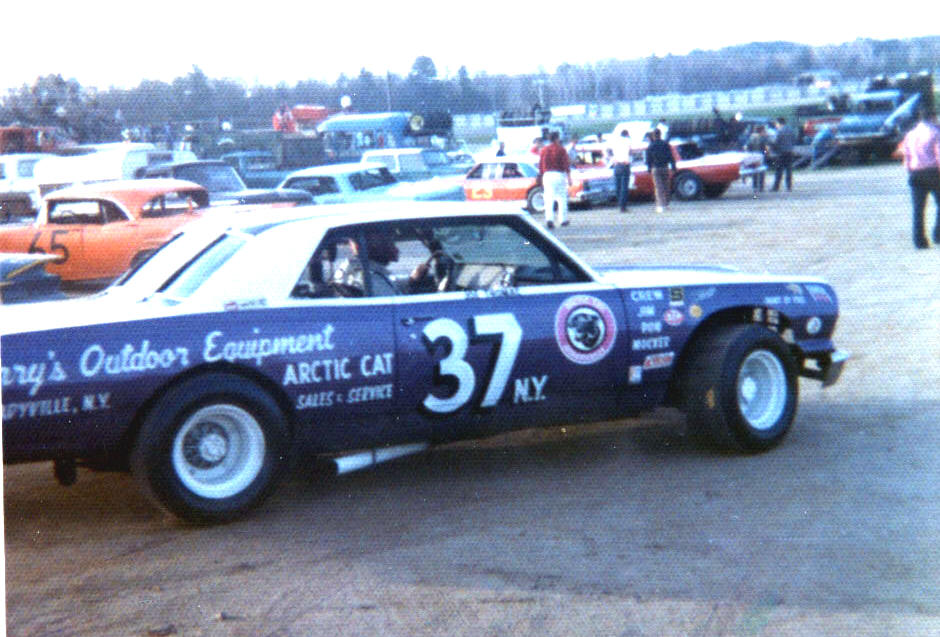
Ladabouche Photo
This shot I took of Joe Thomas in the Jimmy Guynup LMS ended up getting
the McRae Pontiac Hurricane in the background. Below – This shot of Barney
and wife, Fran at Catamount captures Mr. McRae in the background, looking
at the tow vehicle.
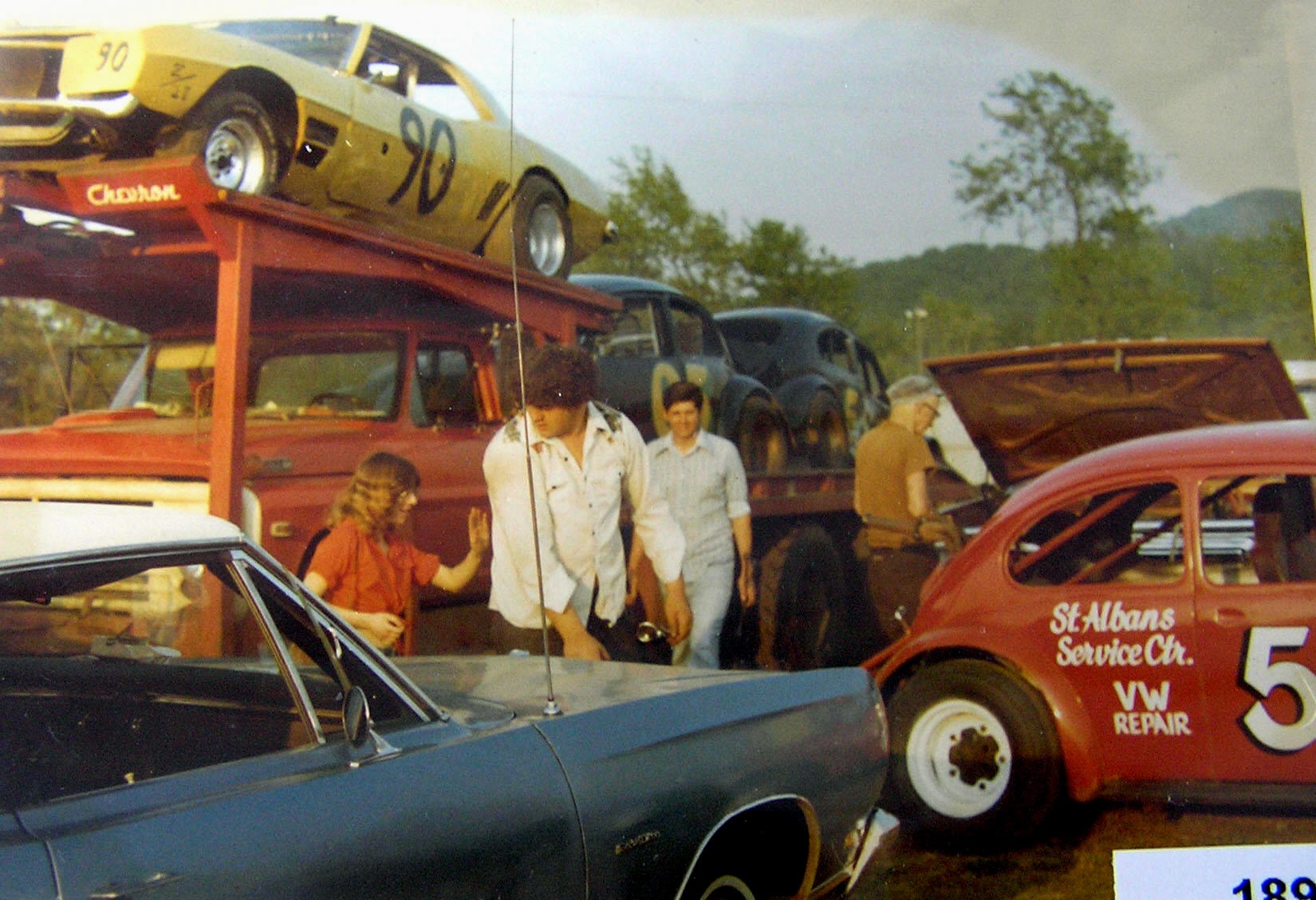
Courtesy of Cho Lee
The
family patriarch clearly did not supply the genes for the size of the boys – the
mother did. Mr. McRae was a very slender older man who was dwarfed by his big
boys, but still clearly in charge. Mrs. McRae was a strapping woman, and the
boys took after her. The family all helped with the orange behemoth of a race
car, and Mrs. McRae kept everyone well fed all evening with food she had packed.
The division was beginning to develop better - performing race cars, and was
also developing a new batch of stars to race them. George McRae was not quite in
that category that first year, but he put in a respectable first year with the
orange #65, the color and number of which would become a trademark for years to
come. He had built the car mostly at home, and I suppose the paint was something
he came by for little money.

Courtesy of Cho Lee
This is the only shot I have of
the Ford, which George hauled all over
and with which he won a number of races. Below – Barney, meanwhile, began with
this VW
shown pitting as John Mascitti takes a victory lap at Catamount.

Courtesy of Paul Mascitti
As did most of the Hurricane teams, the McRae race effort improved greatly the
following year. George now had a 1964 Ford Fairlane to run, and he was much
better. Built at Rocheleau Motors, a St. Albans AMC dealership where George was
working, it was a much more competitive machine. The Hurricanes were beginning
to run a very ambitious race schedule by the mid 1970's according to George, and
– besides Catamount and Thunder Road – they could be running at such farflung
places as Sanair, Airborne, Devil's Bowl, and at Champion Speedway [a Little
track located on some salvage yard property outside of Bedfor,d Quebec.
Airborne and Devil's Bowl were also running automatic transmission cars [like
the Hurricane], called Chargers,. This class had been developed for the Albany –
Saratoga Speedway in Malta, NY, a track that was cooperating with the then –
paved Bowl and Airborne. I recall Jim Cayea, Ron Bonnette, and George as the
main competitors from Catamount who ran the other two tracks. The Bedford track
welcomed the Hurricanes and treated them like a top tier class.
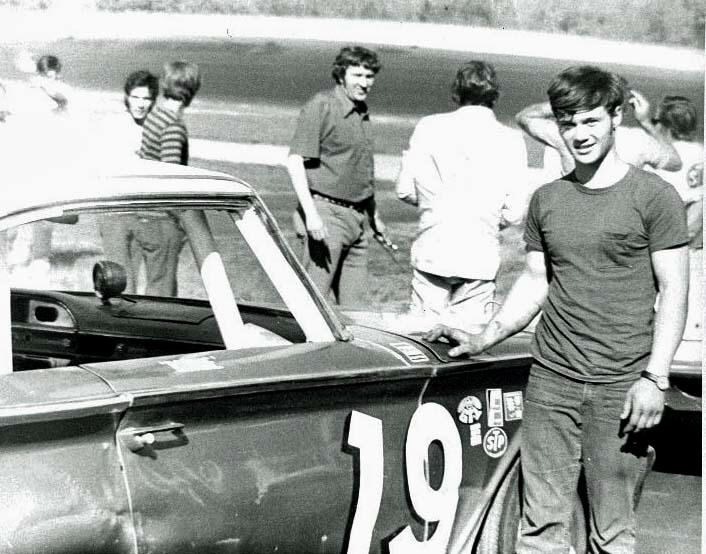
Courtesy of Cho Lee
Ron Bonnette, then known as the
“16 Year – old Sensation” would often travel with fellow St. Albans native
George McRae to
Devil's Bowl or Airborne. Above, he is posing with his Hurricane at Catamount as
Ken Squier keeps a watchful eye in
the background. Below – with the same car as a Charger at Devil's Bowl.
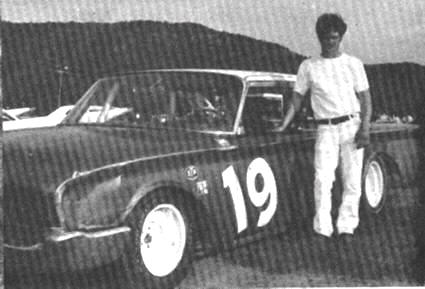
From the Devil's Bowl Program
George would run the Ford until around the end of the 1975 season. Now working
with Milton's Paul Robar, co – owner of the Beaver Dragon Country Dollar late
model sportsman, George was convinced to try fielding an AMC car. Robar and
Steve Hibbard helped McRae get an AMC Hornet and rework the frame as much as
rules allowed so that any flexing worked in their favor.
The first Hornet was McRae's characteristic orange, with the number 65. George
had discovered Clifford King Engineering in California, a speed shop that
specialized in AMC race car and which was very intrigued in what he was doing.
While the King shop worked mostly on AMC road racing cars, it did send for the
AMC engine [and those engines never lacked for power].

Hemmings Site Image
I don't have a photo of the first Hornet, but
it may have looked something like this when it was new.
With a lot of influence from Hibbard, the purchased Hornet had gone through
intensive preparation. Hibbard insisted that the frame be scraped to remove the
AMC factory under coating, and that the frame be re-configured. In mid
construction, Hibbard left he scene and a man named Bill Hazen came in to help.
George says the front end geometry on this Hornet was like nothing anybody else
had. With different A frames and no sway bars, the setup allowed the car to keep
the weight on the front end balanced even under speed in the corners. This, more
than some super engine gave George the edge he seemed to have with the car.
The Hornets had a 258 C.I. engine,and some loophole in the way AMC motors were
configured allowed McRae to have a Holley 650 two barrel carburetor, which
allowed more air to to the cylinders than most of the GA cars could get.
I recall getting getting the newly – finished Hornet to letter before the
season. It was to create quite a stir, as did Dave Gibb's Javelin, as Catamount
was converting over to eventually having its support class be six cylinder cars.
That transition season, the Northern NASCAR organization returned to using the
term “limited sportsman”, as it had the grandfathered eight cylinder Hurricanes
and the six cylinder pony cars running together.
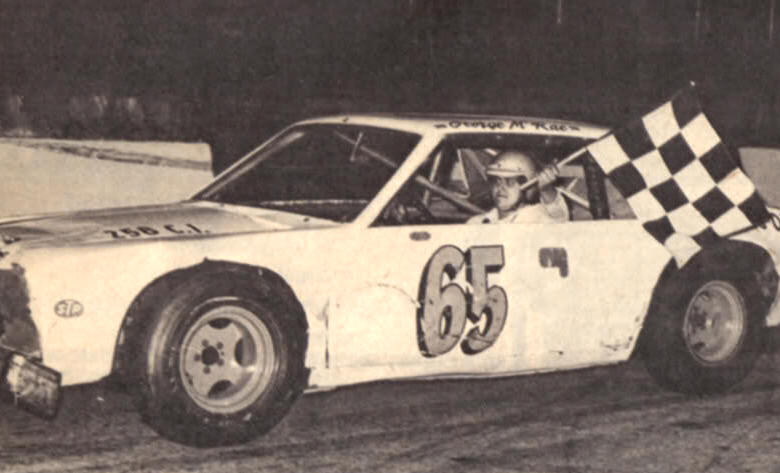
Helen Owen Photo
via Andy Boright
George claims to have won less in the white Hornet than the orange one.
However, I have three separate win photos of the white one. I have no photos of
the orange one when it was first out.

Courtesy of Walter Newell
Drivers who started out with a six among the huge thundering Hurricanes included
George, Jim Barton, Larry Caron, Gibbs, and a few others. It wasn't that easy,
as the resentful Hurricane teams were as rough on the smaller cars as they could
get away with. They tended to give the tough – as – nails Barton a bit wider
berth than the rest, but the final champion, Norm Andrews, was driving a
Hurricane.
By the following year, 1977, the class was called Grand Americans, and the huge
Hurricanes were history. George would run the Hornet against the likes of
Richard Buzzi and Tom Waters with their potent Camaros, Jay Yantz with a fast
Mustang, Paul Donahue, who was trying to get a Mopar straight six competitive,
and dozens more. Woodstock's Bruce Jaycox actually fielded a full – sized Ford
Fairlane with a six cylinder motor.

Courtesy of Andy Boright
Some competition for George came
from the likes of Joe Myers [the Ray Lasnier – built 08 Firebird]
and Jay Yantz in his potent Mustang. Below – the full – sized Jaycox six
cylinder Ford.
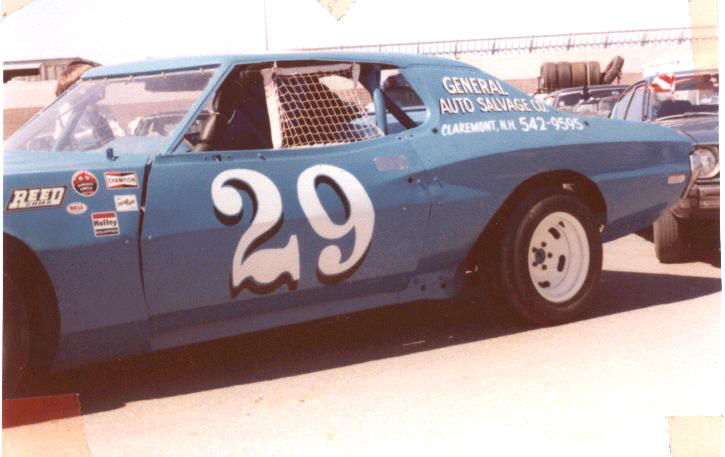
Courtesy of Mark Austin
George's Hornet was a rocket, and he won features that season at Catamount and
at Thunder Road. By now, while brother Gordon had distanced himself from the
family and from racing, Barney had been racing in the mini stock division for at
least a season by now. At the end of the 1977 season, George had been talking
extensively with Milton garage operator Frted Paulette, who convinced him to
build another Hornet. While the orange Hornet had been built mostly at Robar's
B&R Motors, this one would be built at Paulette's.
However,
things soon went South, as there was not adequate funding for the project as
Paulette had envisioned it. George moved out and managed to rent space in one of
the barns on the Sonny Barrett property, out in Checkerberry Village not far
from where the Milton dragstrip had been. McRae would maintain that space for
quite a while and develop a close friendship with the Barrett family that lasts
to this day.

George McRae Collection
Ho hum, another win
for the Hornet. Below – The reconfigured Hornet when Barney ran it.
The new car, being quite different in design from the original orange car, was
painted white and brought to me for lettering. He had secured Buyers' Digest, a
local shopping paper, as sponsor. The original car was not dismantled, but was
put out to pasture. It was a good thing as George never liked the handling
characteristics of the white car as much. Built more solidly than the orange
car, it was less flexible; he did, however win a race or two with it. George
says that, at this time, he also tried driving a car John Merrick had built
working with convicts at the local prison. It may have been a Valiant.
Some time in 1978, Barney decided to give a different division a try and the
orange Hornet was dragged out of the weeds, fixed up, repainted orange, and
christened with Barney's #56. Barney was at his wit's end with car. He had
developed driving habits with the Volkswagens in the mini stock class and was
trying to drive the Hornet the same way with no success. With the VW's, you
lifted in the turns; but, with that flexible AMC, you couldn't [and really
didn't need to].

Ladabouche Collection
George would eventually try this
Zervakis car that had once been
Bob Dragon's dominant AutoMaster Honda entry. Below- The
Nova taking off after a pit stop in the Catamount infield.
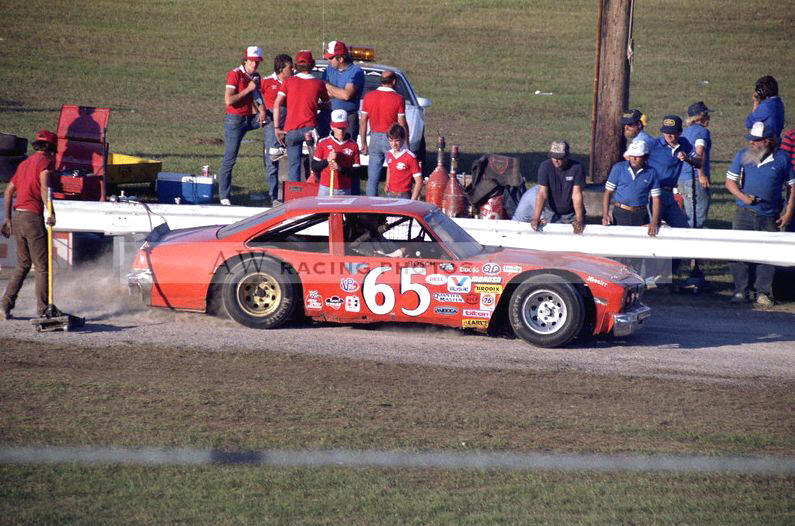
A and A Ward Photo
Finally an exasperated George took the orange car out to prove his point and won
the first race he was in. At the end of the season, they were holding a three
part race similar to a Milk Bowl for the Grand American cars. George took the
car out and won both the heat and the semi feature. Barney was leading the
feature when it rained, and the race was never continued. By the following year,
Barney was looking to move up to the late model ranks, and George was too busy
trying to grow his garage and wrecker business to race. One of the Hornets was
sold to Mark Austin, who [with Barney] put the body from the other Hornet on the
better frame.
This was Barney's last ride was that car before he began a long relationship
with Henry Thibault. They would obtain a Pontiac Ventura late model sportsman
and begin several years of running with the big boys. George would, one day, buy
Bob Dragon's Emmanuel Zervakis – chassised Chevrolet [the Automaster Honda car]
and try racing once again. He had gotten the car from Blair Bessette, who had it
for a brief while as a blue #55.
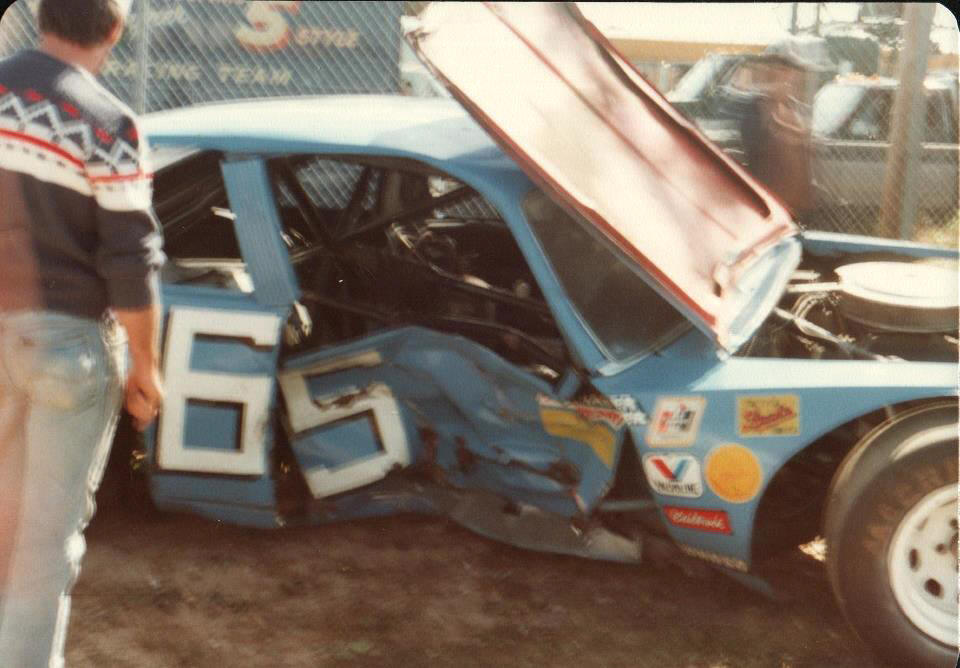
Courtesy of Aaron Maynard
I don't know if this is the bad
Oxford crash or not, but it sure as
hell qualifies as a BAD crash. Below- George had this late model
towards the very end of Catamount.
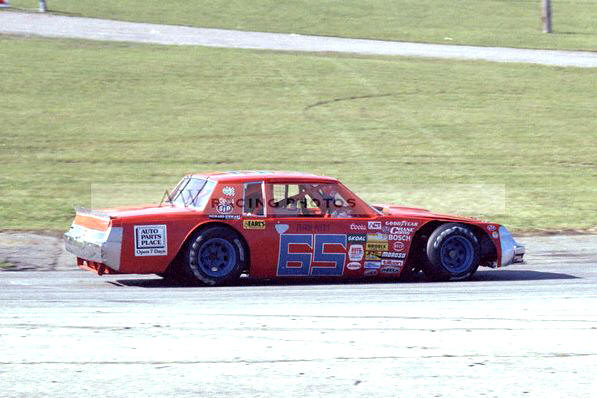
A and A Ward Photo
George was running the Nova – bodied car at Oxford Plains Speedwsay in one of
the Oxford open races when he was involved in a bad wreck. Apparently Zervakis
had installed tubing that was not large enough for specs but looked OK to the
naked eye. The car folded so badly George said he was left sitting in the car,
with one arm hanging out the right window and one hanging out the left. [He's
big, but not that big].
George says Dragon was horrified at what had happened and had said that – had he
know n this about the car – he wouldn't have felt safe competing in it. That car
still sits out back of McRae's business today. George was convinced he had no
more business racing, as he had a business to run that was not going to survive
waiting for him to recover from injuries or trying to share his resources with a
race car.

Source Unknown
This is the trademark
McRae look now.
And, true to form, he has a fine business today. The huge black
wreckers that simply say “McRae” on the door can be seen far and wide.
The garage also does well. His wife and stepson are involved in the
operation of the business, as well. The George McRae AMC Hornets are
some of the best – remembered cars from the long – closed Catamount
Stadium. Sometimes, it just pays to take the road less traveled -[even
in the race business].
Please email me if you have
any photos to lend me or information and corrections I could benefit from.
Please do not submit anything you are not willing to allow me to use on my
website - and thanks. Email is:
wladabou@comcast.net . For those who still don’t like computers - my
regular address is: Bill Ladabouche, 23 York Street, Swanton, Vermont 05488.
AS ALWAYS, DON’T FORGET TO CHECK OUT THE
REST OF MY WEBSITE
www.catamountstadium.com
Return to the Main Page
Return to the Main News Page
Return to the All Links Page
Return to the Weekly Blog Links Page











